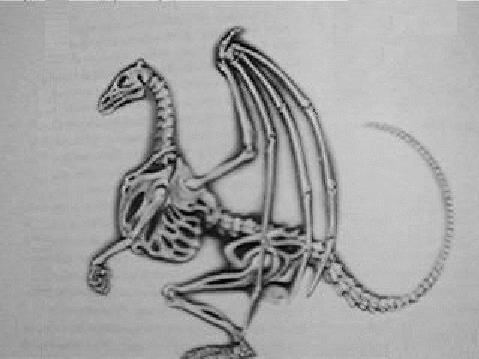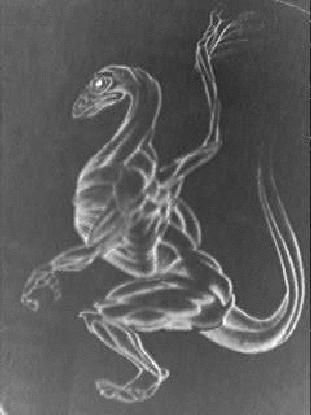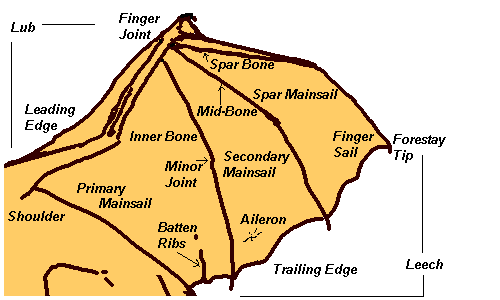Dragonhealing - Dragon Anatomy, Senses and General Information
Home > Manuals > Dragonhealing > Dragon Anatomy, Senses and General Information
Skeletons and Muscles
Dragonkind have a skeletal structure that is not of easily-breakable bones, like ours, but of light, flexible plates. The rib cage of a dragon is comprised of a single piece and is surprisingly large, allowing a dragon's chest to double its size upon full inflation. Both dragons and firelizards rely on modified ball-and-socket joints in their legs to keep their knees from dislocating on takeoff and landing.
The first two wing bones run almost together, as the bones form the outer spar portion of the lub--the term in Seacrafting applied to the support for a square sail. The remaining two wing bones fan out from the finger joint. The inner bone is almost perpendicular to the spar bone, and ends about midway between the body and the forestay finger tip.
Both the front and rear limbs of dragons and firelizards, have pentadactyl (five-fingered) claws, jointed much like a human's hand. There are unreliable reports of three-clawed firelizards having been spotted in the Southern Continent; this is likely to be a Harper's tale, however. The front limbs are fitted with long, sharp talons for hunting, while the rear limbs have softer nails, although still substantially tougher than humans'. (See Figure 1)
Dragons are muscular. The back legs of dragons in particular are massive with muscle, to enable them to leap far off the ground when they take off. Muscles are a glistening silver-gray in appearance. Firelizards' limbs are more equal in length and musculature than dragons', which accounts for the firelizards spending less time upright in a 'sitting' position. (See Figure 2)

Figure 1. Dragon skeleton

Figure 2. Dragon musculature

Skin
Dragon hide is smooth, soft to the touch, strong, and hairless. A healthy hide is glossy with no hint of grey.
Hide must be kept oiled, or dry, patchy spots may develop which can crack painfully during a trip between. This is especially important for weyrling dragons, where their rapid growth makes oiling a daily -- if not more frequent -- necessity.
The female golds and greens often experience a change in tone before mating; just before a flight they may even appear to glow. The male bronzes, browns, and blues generally do not experience this fluctuation in color, although their hides may gradually deepen with age.

Internal Systems
Dragonkind have a large lung capacity, so that when they inflate their dorsally-placed lung sacs, their chest can swell to double its normal size.
They have two stomachs, one for food and the other for the digestion of firestone.
Dragonkind have several hearts, similarly placed to ours under their ribcages.
Dragonkind are 'warm blooded', though slightly cooler than humans. They do not have red blood but, rather, a dark green ichor. Ichor, like blood, is based on metal, in this case copper. Dragonkind flesh is therefore greenish instead of the pink associated with humans.

Tails and Wings
Dragonkind have forked tails, almost arrowhead-shaped. In the fork is their sphincter. Dragons and firelizards will store up excreta for several days in their tails until they are able to go between and get rid of it there. A dragon who cannot go between will have to have their rider muck out their weyr.
Their genitalia are concealed behind pouch like flaps of skin under the junction of tail and body, and are only revealed during mating.
Because the wings functions somewhat like sails, the terms used are quite similar. (See figure 3)
About half the length of a dragon wing is supported by bones that are shaped similar to arms between the shoulder and the finger joint, including an elbow. The strength of the shoulder and upper arm muscles supply the power necessary for a 'lift.' The elbow has a slightly flexed position, and the leading edge of the wing is a membrane which stretches between the shoulder and the finger joint.
From the dorsal spine and stretching to this inner bone is the primary mainsail, the largest of the three membranes, which supports most of the body's weight. The secondary mainsail runs from the inner bone to the mid bone, and the spar mainsail runs from the mid bone to the spar bone(s). They are used in support as well, but also provide maneuverability. The outermost tip is able to function almost independently, giving it the term 'finger sail.' These membranes are translucent in the firelizards and nearly so in the dragon's, but thicker over the bones and where they attach to the muscles, and are much stronger than they appear. Cartilage provides additional support, extending from arm and finger joint to the leech or trailing edge.

Figure 3. Dragon wing structure

Senses and Between
A dragon's headknobs are more prominent than those of a firelizard and their noses more pointed. Dragonkind have no ears or eyelashes. Their headknobs appear to function as our ears do, for they react to noises that are not related to their sixth sense.
The eyes are protected both by the prominent eyeridges and by three sets of lids: an inner transparent pair and two increasingly thicker sets of membranes. Eyes are multifaceted and color reflects mood: green/blue signifies contentment, yellow fear, red/orange anger, red hunger, danger white and purple signifies the mating urge and love.
Dragons' and firelizards' senses of smell aren't that well developed. The teeth are strong, sharp at the front for hunting and more molar like at the back of the mouth for chewing firestone. Their tongues are forked.
Between is the strange, cold, black area of nothingness dragons go through when they teleport across vast distances. To successfully travel between a dragon must have a clear telepathic visualization of the area. The more precise the visualization, the safer the trip. Riders tend to be very good at visualizing locations, and because of the empathic bond between rider and dragon, a well trained pair can between to any location they know well enough.
It is possible to between through time, by accurately visualizing the precise moment in time that one wishes to visit. However, betweening through times is expressly forbidden due to the danger involved. If a rider does not visualize the time and place exactly, they may come out in the wrong time or they may never come out of between at all. Because of the risks, any rider who attempts to between times without their Weyrleader's permission is grounded from Threadfall, assigned Star Stones duty, and will join the weyrling class lecture on the dangers of between.

Life Cycle
The dragon life cycle is fairly simple and can be broken down into four main categories: flights, clutches, hatchings and death.
All female dragons (that is, gold and green) rise to mate in a flight. With green dragons, they can rise up to three times a turn, but more often only once or twice. Any male dragon can catch a green; however, no clutch will produce from the mating. Gold dragons rise more infrequently, and generally only when the Weyr needs a clutch. Only brown and bronze dragons can catch a gold, and only a bronze/gold mating flight will produce a gold egg. Generally, only bronzes can catch Senior gold dragons, but this is felt to be due to the mental pressure of the Weyr in general, as they expect a bronze to win.
Before a female dragon rises to mate, she may become irritable and moody, often sharing those feelings with her rider. At this stage, a dragon and rider are considered to be proddy, and it is often wise to let them be. Hours or perhaps minutes before the flight itself, the female dragon will begin to glow. It is possible to mistake this glow for a fresh oiling or a good sunning.
At this point, all the male dragons who are interested in chasing will begin to blood their kills in the feeding grounds (the resultant kills are used to feed injured dragons, as scrap food for other animals that prefer raw meat, or boiled down into glue). After a few minutes, the female dragon will join her suitors, also drinking the blood of her kills. The dragons drink blood to get a quick boost to their energy, without weighing themselves down with the actual meat.
When she's ready, the female dragon will leap into the sky and be chased by the males. The flight will go on until the female gets tired or a cagey male dragon cuts her off. Some female dragons are known for choosing their mates, while others allow whichever male is closest to twine tails.
In the case of a green dragon, the story ends there. The dragons mate, their riders do as well, and everyone goes to sleep. For a gold dragon, however, the length of flight becomes important. The longer the flight, the larger the clutch, and in the middle of the Pass, more dragons are usually needed.
Over the next four to six months, the gold dragon will carry and develop eggs. This length of time is not canonical, but tweaked to fit in with the OOC necessity of hatching schedules. The gold's stomach will stretch and appear to grow larger, as she must carry twelve to fifty eggs. Finally, she will announce to the Weyr that it is time by humming, and take to the hatching sands to lay her eggs.
It takes anywhere between one day and five for a gold to lay all her eggs, depending on how many there are total. Once the first egg hits the sand, however, the Weyr switches into high-gear, and searchriders are sent to find prospective new riders. Over the next four to six months (again, this time is not canonical and is tweaked for OOC necessity), young Pernese are brought in to become Candidates, and to stand on the sands in the hopes of Impressing a dragon.
On Hatching Day, the dragons will again hum, the Candidates will be ushered to the sands, and the eggs will hatch. Of the eggs that hatch, all impress by psychically bonding with their chosen lifemate. While the impression pairs often confuse people, it is understood that the dragon will make the best choice for itself. The newly impressed pairs, now Weyrlings, are taken to the Weyrling Barracks. For the eggs that don't hatch, the Weyrleader (or clutch sire) must fly them between and leave them. The Candidates who do not impress are almost always welcome to stay at the Weyr as a resident (or crafter), or are taken home the next day.
Most dragons die in Threadfall or in accidents traveling between. In a Pass, it is exceptionally rare for dragons to die from old age, however it is quite possible for them to do so. A dragon will always die if their rider dies by going between and not returning. Riders occasionally outlive their dragons, but many take a mercy draught as they are never quite in their right mind afterwards. If at all possible, an injured dragon will make one last jump between shortly before their death, however if they are unable to do so, it is the Weyrleaders' responsibility to ferry the deceased dragon between.
